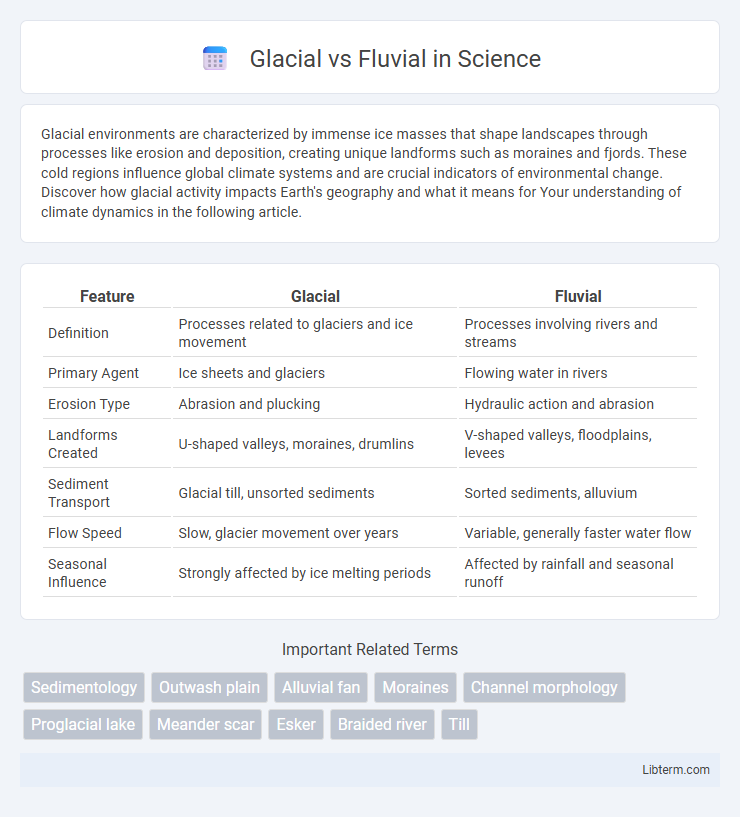Glacial environments are characterized by immense ice masses that shape landscapes through processes like erosion and deposition, creating unique landforms such as moraines and fjords. These cold regions influence global climate systems and are crucial indicators of environmental change. Discover how glacial activity impacts Earth's geography and what it means for Your understanding of climate dynamics in the following article.
Table of Comparison
| Feature | Glacial | Fluvial |
|---|---|---|
| Definition | Processes related to glaciers and ice movement | Processes involving rivers and streams |
| Primary Agent | Ice sheets and glaciers | Flowing water in rivers |
| Erosion Type | Abrasion and plucking | Hydraulic action and abrasion |
| Landforms Created | U-shaped valleys, moraines, drumlins | V-shaped valleys, floodplains, levees |
| Sediment Transport | Glacial till, unsorted sediments | Sorted sediments, alluvium |
| Flow Speed | Slow, glacier movement over years | Variable, generally faster water flow |
| Seasonal Influence | Strongly affected by ice melting periods | Affected by rainfall and seasonal runoff |
Introduction to Glacial and Fluvial Processes
Glacial processes involve the movement and melting of glaciers, which shape landscapes through erosion, transportation, and deposition of sediments. Fluvial processes are related to the action of rivers and streams that erode, transport, and deposit sediments, creating features such as valleys, floodplains, and deltas. Both processes significantly influence Earth's surface topography but operate through different mechanisms and environments.
Key Characteristics of Glacial Landforms
Glacial landforms are primarily shaped by the movement and melting of glaciers, creating distinctive features such as moraines, drumlins, and eskers composed of unsorted till and stratified sediments. These landforms often display U-shaped valleys, fjords, and cirques formed through processes like plucking and abrasion, indicative of glacial erosion. Unlike fluvial landforms, which result from river activity, glacial landforms are characterized by their association with ice dynamics and the deposition of glacial till.
Distinctive Features of Fluvial Landforms
Fluvial landforms are shaped primarily by the action of rivers and streams, characterized by features such as meanders, oxbow lakes, and floodplains formed through sediment deposition and erosion. These landforms display a continuous process of sediment transport and channel migration, creating valleys with V-shaped profiles and terraces indicative of changing water levels. Fluvial systems also develop distinctive features like deltas at river mouths, where sediment accumulation creates fertile and dynamic landscapes.
Sediment Transport: Glacial vs Fluvial Dynamics
Glacial sediment transport involves the movement of large, angular debris embedded in ice through processes like abrasion and plucking, resulting in poorly sorted sediments called till. Fluvial sediment transport occurs through water flow, sorting particles by size and density via mechanisms such as suspension, saltation, and traction within river channels and floodplains. Glacial dynamics produce dominant sediment features like moraines and outwash plains, while fluvial systems create stratified deposits including alluvial fans and river terraces, reflecting distinct transport and depositional environments.
Erosional Mechanisms: Glacier Action versus River Action
Glacial erosion primarily occurs through processes such as plucking and abrasion, where moving ice entrains and scrapes rock surfaces, creating U-shaped valleys and striations. Fluvial erosion is dominated by hydraulic action, abrasion, and solution, where flowing water dislodges, transports, and dissolves sediments, sculpting V-shaped valleys and river channels. Both mechanisms significantly reshape landscapes but differ in energy sources, sediment transport methods, and resulting landform geometries.
Deposition Patterns in Glacial and Fluvial Environments
Glacial deposition patterns feature unsorted sediments called till, forming moraines, drumlins, and eskers due to ice movement and melting processes. Fluvial deposition creates well-sorted sediments in distinct layers such as point bars, levees, and floodplains shaped by water flow velocity and sediment load. The heterogeneous grain size distribution in glacial deposits contrasts with the stratified, finer deposits typical of fluvial environments.
Influence of Climate on Glacial and Fluvial Activity
Glacial activity intensifies in colder climates, where low temperatures promote ice accumulation and glacier formation, significantly shaping landscapes through erosion and deposition. Fluvial activity, driven by precipitation and temperature variations, influences river discharge, sediment transport, and channel morphology, often increasing during warmer, wetter periods. Climate fluctuations directly impact the balance between glacial and fluvial processes, dictating the dominant geomorphic forces in a given environment.
Geomorphological Impact: Shaping the Landscape
Glacial geomorphology primarily sculpts landscapes through processes like erosion, transport, and deposition of rock debris, creating features such as U-shaped valleys, fjords, and moraines. In contrast, fluvial geomorphology shapes terrain by riverine actions including erosion, sediment transportation, and deposition, resulting in V-shaped valleys, floodplains, and alluvial fans. The differential impact of glaciers and rivers profoundly influences topographic diversity, sediment distribution, and habitat formation in various climatic regions.
Human Interactions with Glacial and Fluvial Systems
Human interactions with glacial systems primarily involve water resource management and climate impact monitoring, as glaciers act as critical freshwater reservoirs feeding rivers during dry periods. Fluvial systems are extensively modified through dam construction, irrigation, and urban development, altering natural flow regimes and sediment transport. Both systems face challenges from anthropogenic climate change, affecting water availability, ecosystem health, and regional livelihoods.
Conclusion: Comparing Glacial and Fluvial Processes
Glacial processes are characterized by the movement of ice shaping landscapes through erosion and deposition, creating features like moraines and U-shaped valleys, while fluvial processes involve water flow sculpting landforms such as river valleys and floodplains through sediment transport. The distinct mechanisms of glacial abrasion and plucking contrast with the hydraulic action and sediment load of rivers, resulting in unique geomorphological patterns. Understanding these differences is essential for interpreting past climate conditions and managing natural resources in glaciated versus riverine environments.
Glacial Infographic

 libterm.com
libterm.com